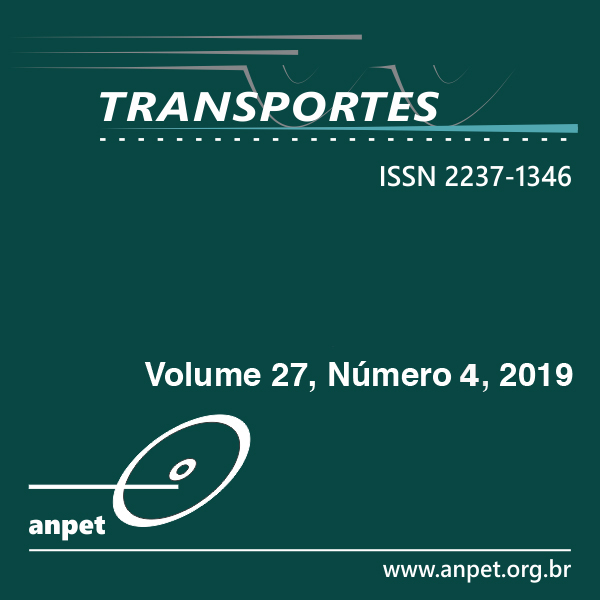Aplicação de métodos determinísticos para a obtenção de gap crítico em rotatórias urbanas brasileiras
DOI:
https://doi.org/10.14295/transportes.v27i4.1866Keywords:
Roundabout, Critical gap, Capacity.Abstract
This paper focuses on evaluating the critical gap and the follow-up headway for Brazilian roundabouts and on comparing it to the results of foreign studies. Three two-lane roundabouts were selected to obtain the critical gap through five methods: Siegloch (1973), Raff (1950), Miller & Pretty (1968), Wu (2012) and Bunker (2012). Through the first method, it was also possible to obtain the follow-up headway. The critical gap values were considerably different in each lane: on the right lane, the drivers accepted smaller gaps to cross to the intersection. This difference was not significant when it came to the follow-up headway. After that, the critical gap estimation methods were validated by comparing the intersection’s capacity using the Hagring (1998) method with the combined data per minute of traffic flow. Finally, the resulting Brazilian values were compared to foreign data. There were similarities to the results found in countries like Switzerland, Italy and Portugal.Downloads
References
Bunker, J.M. (2012) Novel Methods and the Maximum Likelihood Estimation Technique for Estimating Traffic Critical Gap. Journal of Advanced Transportation, v. 48, nº 6, p. 542-555. DOI: 10.1002/atr.1204.
Federal Highway Administration (2010) Roundabouts: Na Informational Guide. 2ª Edição. McLean: U. S. Department of Transportation.
Gazzarri, A.; M. T. Martello; Antonio P. e Reginald R. S. (2012) Estimation of Gap Acceptance Parameters for HCM 2010 roundabouts Capacity Model Applications. XVIII Urban Transport: Urban Transport and the Environment in the 21st Century, V. 128, p. 309-319. DOI: 10.2495/UT120271.
Hagring, O. (1998) A further generalization of Tanner’s formula, Transportation Research Part B: Methodological, v. 32, nº6, p. 423-429. DOI: 10.1016/S0191-2615(98)00010-1
Hagring, O. (2000) Estimation of Critical Gaps in Two Major Streams. Transportation Research Part B: Methodological, v. 34, nº 4, p. 293-313. DOI: 10.1016/S0191-2615(99)00026-0
Hagring, O.; N. M. Rouphail, e H. A. Sorensen (2003) Comparison of Capacity Models for Two-Lane Roundabouts. Journal of the Transportation Research Board, v 1852, p. 114-123. DOI: 10.3141/1852-15
Lindenmann, H. P. (2006) Capacity of Small Roundabouts with Two-Lane Entries. Journal of the Transportation Research Board, v. 1988, nº 1, p 119-126. DOI: 10.1177/0361198106198800115
Mahesh, S.; A. Ahmad e R. Rastogi (2014) An Approach for the Estimation of Entry Flows on Roundabouts. Transportation Planning and Implementation Methodologies for Developing Countries, v. 17, p. 52-62. DOI: 10.1016/j.trpro.2016.11.060
Miller, A.J. e R. L. Pretty (1968) Overtaking on Two-Lane Rural Roads, 4th Australian Road Research Board Conference, v. 4, nº1, p. 582-594.
Polus, A.; Y. Shiftan e S. Shmueli-Lazar (2005) Evaluation of the Waiting-Time Effect on Critical Gaps at Roundabouts by a Logit Model. European Journal of Transport and Infrastructure Research, v. 5, nº 1, p. 1-12.
Raff, M. e J. Hart (1950) A volume warrant to urban stop signs. Eno Foundation for Highway Traffic Control, Saugatuck.
Rao, S.; Y. Krishna; P. Atmakuri e P. Bhuyan (2016) Calibration of Performance of Roundabouts Based on Gap Acceptance Parameters Using Simulation for Indian Scenario. Transportation Planning and Implementation Methodologies for Developing Countries, v. 12.
Rodegerdts, L.; M. Blogg; E. Wemple; E. Myers; M. Kyte; M. Dixon; G. List; A. Flannery; R. Troutbeck; W. Brilon; N. Wu; B. Persaud; C. Lyon; D Harkey e D. Carter (2007b). Roundabouts in the United States. NCHRP report 572, Washington, DC: The National Academy of Sciences.
Siegloch, W. (1973) Die Leistungsermittlung an Knotenpunkten ohne Lichtsignalsteuerung, Strassenbau und Strassenverkehrstechnik v. 154. Federal Ministry of Transport.
TRB (2010) Highway Capacity Manual. Transport Research Board. 6th. Edition. Washington: National Academy of Science.
Vasconcelos, A. L. P. (2014) Análise do Desempenho Operacional de Rotundas: Modelos e Aplicações. Tese (Doutoramento em Engenharia Civil) – Faculdade de Ciências, Universidade de Coimbra, Coimbra.
Wu, N. (2012) Equilibrium of Probabilities for Estimating Distribution Function of Critical Gaps at Unsignalized Intersections. Journal of the Transportation Research Board, v. 2286, p. 49-55. DOI: 10.3141/228606.
Downloads
Published
How to Cite
Issue
Section
License
Authors who submit papers for publication by TRANSPORTES agree to the following terms:
- The authors retain the copyright and grant Transportes the right of first publication of the manuscript, without any financial charge, and waive any other remuneration for its publication by ANPET.
- Upon publication by Transportes, the manuscript is automatically licensed under the Creative Commons License CC BY 4.0 license. This license permits the work to be shared with proper attribution to the authors and its original publication in this journal.
- Authors are authorized to enter into additional separate contracts for the non-exclusive distribution of the version of the manuscript published in this journal (e.g., publishing in an institutional repository or as a book chapter), with recognition of the initial publication in this journal, provided that such a contract does not imply an endorsement of the content of the manuscript or the new medium by ANPET.
- Authors are permitted and encouraged to publish and distribute their work online (e.g., in institutional repositories or on their personal websites) after the editorial process is complete. As Transportes provides open access to all published issues, authors are encouraged to use links to the DOI of their article in these cases.
- Authors confirm they have obtained all required employer permissions for the publication and CC BY 4.0 licensing of the manuscript, particularly if the employer holds any claim to the manuscript's copyright. Authors assume all responsibility for employer-related copyright issues, releasing ANPET and Transportes from any related liability.
- Authors assume full responsibility for the content of the manuscript, including the necessary and appropriate authorizations for the disclosure of collected data and obtained results, releasing ANPET and Transportes from any responsibility in this regard.
Last update: 11/27/2025











